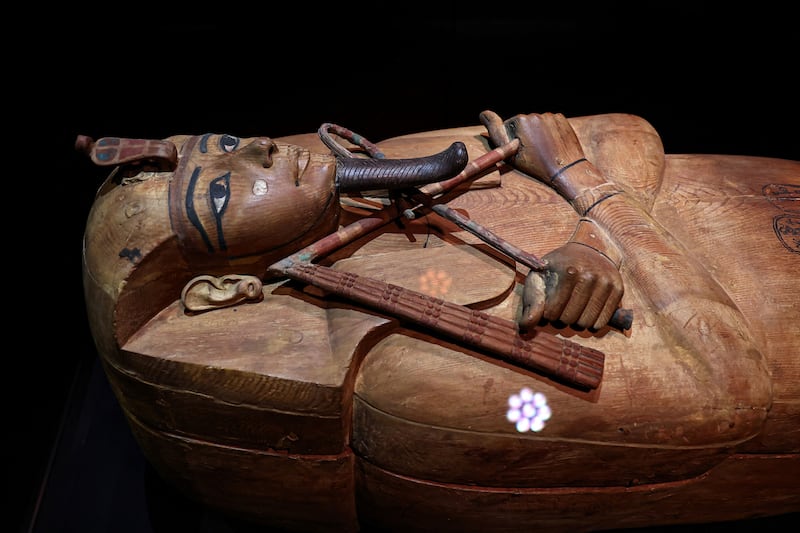Archaeologists find missing top half of Ramses II statue in Egypt
Uncovered head and torso a match for the lower section discovered in 1930 by a German archaeologist

The top half of a statue of Egyptian pharaoh Ramses II has been unearthed in southern Egypt, the Ministry of Tourism and Antiquities has revealed.
The discovery by an Egyptian-US mission completes the statue after the lower half was discovered in the same area, the Ashmunein region of Al Minya province, almost a century ago.
The top section, 3.8 metres tall, depicts Ramses II's head, shoulders and upper torso.
The pharaoh is portrayed wearing the dual crown indicating his rule over both Egypt's Upper and Lower kingdoms. A cobra, a symbol of royalty in ancient Egypt, can be seen at the front of the crown.
Preliminary scans of the limestone block have confirmed that it is part of the statue of Ramses II statue unearthed in 1930 by German archaeologist Gunther Roeder.
Once the two parts are joined, the statue is expected to stand seven metres, said Dr Bassem Gehad, head of the Egyptian team taking part in the excavation mission.
Ramses II, also known as Ramses the Great, was the third pharaoh of the 19th Dynasty of Egypt and ruled from 1,279 to 1,213 BC.
The Egyptian team, working under the authority of the Supreme Council of Antiquities, and with counterparts from the University of Colorado mission, began an excavation in Ashmunein last year to find a religious complex believed to date back to Egypt's New Kingdom era (1550-1070 BC) before collapsing during Roman rule centuries later.
"Though we have not found the complex we were initially looking for, a statue of such importance is a sign that we are digging in the right place," said Adel Okasha, an antiquities official who oversaw the dig.
He said more notable discoveries are expected.
The city of El Ashmunein, on the west bank of the Nile, was known in ancient Egypt as Khemnu and in the Greco-Roman era was the regional capital of Hermopolis Magna.
Dr Salima Ikram, a professor of Egyptology at the American University in Cairo, said the discovery was notable because "it completes the half found many, many years ago".
"Not only is it a wonderful opportunity to have a whole other massive statue of the famed king, it also adds to our general understanding and fills gaps in our data on the large corpus of Ramses II's statuary," Dr Ikram told The National.
"Through each discovery, we have been able to trace changes in the style during the course of his very long reign."
Statues of Ramses II, the longest-reigning pharaoh and one of ancient Egypt's most depicted figures, draw visitors to a number of the country's historical sites including the dual temples of Abu Simbel, in Egypt's southernmost province of Aswan.
The four giant statues of Ramses II that flank the main entrance, each 20 metres tall, gained international fame in the 1960s during an operation to move the temples to higher ground to prevent them being submerged by Lake Nasser, the reservoir of the High Aswan Dam.
Thousands of tourists visit the temples to see the Sun light up a wall engraving of Ramses II in a small chamber inside twice a year. The alignment takes place on February 22 and October 22, said to be the dates of Ramses II's birthday and his coronation day, respectively.
Another statue of the Ramses II once stood in a busy square in central Cairo near its largest train station, both named after the pharaoh, before it was moved to be the centrepiece of the main hall in the Grand Egyptian Museum, a vast complex near the Pyramids of Giza, which has been under construction since 2002 and is nearing completion.
Ramses II's mummy, along with the remains of 21 other ancient kings and queens, was transferred from the Egyptian Museum in Tahrir Square in Cairo in 2021 in a grand parade that was covered by international media and renewed interest in Egyptian heritage worldwide.
-- Sent from my Linux system.


No comments:
Post a Comment